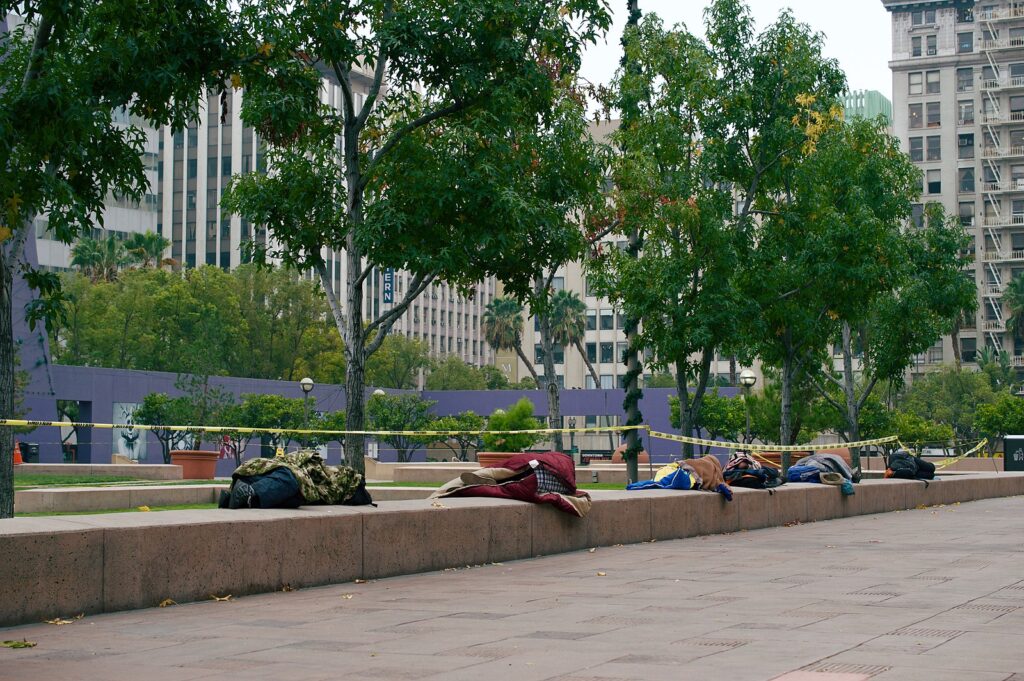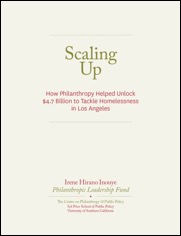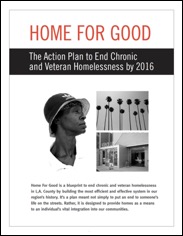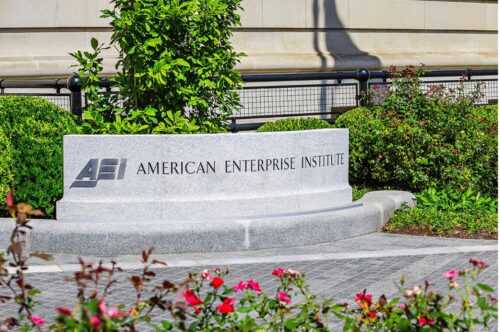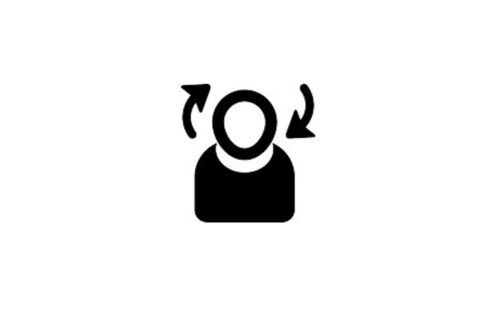In wake of USC Center on Philanthropy & Public Policy’s must-read report, first of three-part series overviews initial ambitions and aspirations of effort led by city’s funders to deal with “wicked problem.”
This is Part 1 of a three-part series. Part 2 is here, and Part 3 is here.
The University of Southern California’s Center on Philanthropy & Public Policy (CPPP) released Scaling Up: How Philanthropy Helped Unlock $4.7 Billion to Tackle Homelessness in Los Angeles in mid-August. Written by CPPP director James M. Ferris and associate director Nicholas P. O. Williams, the report is a detailed and thoughtful account of how philanthropy in a major U.S. city tackled the “wicked problem” of homelessness.
As the title suggests, this was state-of-the-art grantmaking on a grand scale, employing nothing but the latest, cutting-edge techniques. No longer content with piecemeal, isolated, “band-aid” approaches to homelessness, L.A.’s foundations had concluded that their resources alone were hopelessly inadequate for the monumental task before them. After all, Scaling Up notes, by 2017, the homeless count had mounted to 57,794 individuals.
And so they set out to mobilize every resource of the region behind a unified agenda. They “developed a field of action” bringing together philanthropy, business, and government behind the theory of “housing first,” which “suggests homeless persons should not be subjected to preconditions like sobriety before being placed in permanent housing,” as Ferris and Williams describe in Scaling Up.
For the long-term, chronically homeless, however, it was necessary to provide not only housing, but “wraparound services” as well, to help residents achieve sobriety when and if ready, and to address the considerable range of health and economic challenges that accompany residents off the streets. This approach—“permanent supportive housing”—can obviously be quite expensive.
But its supporters claim that, in fact, it more than pays for itself. It saves dollars that would otherwise go to physical and mental-health emergencies, law enforcement, and street sanitation, which alleviate homelessness, but don’t solve the problem. At the same time, less-intensive forms of shelters, temporary housing, and rent assistance are still required for the non-chronically homeless.
Bold promises
In 2010, the local United Way and Chamber of Commerce had come together behind Home for Good, “an initiative to end chronic and veteran homelessness in Los Angeles County by 2016,” according to Scaling Up. (Like many United Ways around the country, United Way of Greater Los Angeles had decided in 2007 to leave behind the old, scatter-shot, community-chest approach to poverty, and to focus instead on three overarching missions, one of which was the housing problem.)
Home for Good’s “action plan” maintained that the service system at the time spent $875 million just managing homelessness, not ending it. Three-fourths of that spending was consumed by the one-quarter of the population that was chronically homeless, however. Placing them into permanent supportive housing would actually save money over the long term, the action plan maintained. Bold headings in the report held out these bold promises: “By redirecting and coordinating our existing resources, we can eliminate homelessness in Los Angeles. By acting rationally and efficiently, we can ultimately spend far less than we do now.”
A “funders collaborative” soon assembled around this effort—which, by 2016, included 27 government-related and 30 private funders, including major L.A. players like the Annenberg, Weingart, Aileen Getty, Pritzker Family, and Conrad Hilton Foundations, as well as the California Endowment. The group raised $34 million for programs from 2012 to 2016, while bringing in $700 million in government dollars.
By 2015, however—one year before expiration of the 10-year plan to end homelessness, and “despite the success of Home for Good in spurring innovations, helping to pool and align resources, and getting the sectors to work together”—it had “become clear that the region was falling further behind,” Ferris and Williams write. Indeed, the point-in-time homeless count conducted in 2015 by the Los Angeles Homeless Services Authority (LAHSA) found that homelessness had increased by 16% over the previous year, to 44,000 individuals. Clearly, a more rational and coordinated delivery of services alone would not meet the promise of ending homelessness.
While the city drafted yet another new plan in 2016 to combat homelessness, this time with 64 strategies, and the county outlined 47 new initiatives of its own, it was evident to the Home For Good collaborative that nothing significant could be accomplished without a massive and sustained stream of public dollars.
And so the Home for Good forces got behind a ballot measure for the November 2016 election: Proposition HHH, a $1.2 billion bond measure to help finance up to 10,000 units of permanent-supportive housing over the next 10 years. Scaling Up observes that “Dozens of nonprofit agencies that provide housing and supportive services for persons experiencing homelessness contributed thousands of hours for person-to-person outreach—including knocking on doors and manning telephone banks—as well as through social media.”
It helped that this was a presidential-election year, enabling “Yes on HHH” campaigners to focus on “ensuring that more liberal voters, which polling suggested supported the bond measure by a wide margin, turned out to vote.” Contributions to the campaign amounted to $2.2 million, which helped secure a 77% “yes” vote.
Shortly thereafter, Los Angeles County took up Measure H. It was designed to raise $3.5 billion over 10 years through a quarter-cent hike in county sales taxes, which would cover “rental subsidies, case management, and mental health services to help prevent homelessness and ensure those who received housing stayed housed”—in other words, backstopping the city’s new housing structures with the supportive services needed to make housing permanent.
The coalition previously behind Proposition HHH again swung into action, with $3.4 million spent on mailings and television spots, while “paid staff and volunteers made more than 550,000 phone calls, knocked on 10,000 doors and tracked 37,100 likely ‘yes’ voters.” Measure H passed, too, in March,2017, with approval by 69.3% of voters.
Scaling Up’s concluding section sums up its “Lessons for Philanthropy.” There was a need to “build a field” by establishing a cross-sector infrastructure that would “frame complex problems within a systems perspective;” to develop “adaptive and distributed leadership;” and to understand that “large scale solutions require engaging government.” The report puts considerable emphasis on this last point, as it should, since the narrative builds dramatically to the passage of the two ballot measures.
Engaging government isn’t just about developing and advocating good policy ideas anymore, we’re told. Rather, philanthropy must be ready to take “a more active role in policymaking at all stages of the process—from helping to frame the ballot measures to working to get them passed.” Scaling Uplays out a roadmap for how philanthropy can be more “proactive in public policy … as more foundations have decided to go ‘all in’ for greater impact in recent years.”
Coordination and collaboration
For those interested in what modern, policy-driven, mega-philanthropy looks like, Scaling Up is a must-read. It captures the large-scale, expert-driven work of sophisticated foundations, embodying the “best practices” taught at our leading schools of philanthropy and nonprofit management. At the heart of this work is the conviction that foundations are well beyond merely making grants to isolated and disconnected poverty nonprofits, but must instead gather all the actors involved into a coordinated, collaborative, multi-year effort. And all of this must be driven by a “theory of change”—in this case, the theory of “housing first”—reflecting the latest social-science research.
But even that isn’t enough. Truly to get at the root causes of homelessness, it’s necessary to mobilize big resources behind a suitably big theory. That’s why foundations need to go “all in” for political activism, a type of engagement that is “not necessarily comfortable for philanthropy given the restrictions on lobbying and the risks involved in failure,” but is essential nonetheless if we’re to do more than merely put band-aids on our problems.
Scaling Up ends on an optimistic note. Philanthropy “has created the infrastructure to help write the next chapter in the Los Angeles story—the implementation of Proposition HHH and Measure H.” Indeed, by the time the annual count of homeless was taken in 2018, totals for the county had dropped modestly, to 52,765. Supporters of the two measures cautiously suggested that, perhaps, Los Angeles voters were beginning to see some results for their $4.7 billion.
But then, this past June—actually, two months before the release of Scaling Up—the homeless count for 2019 burst into the local headlines. Part 2 describes what happened next.
